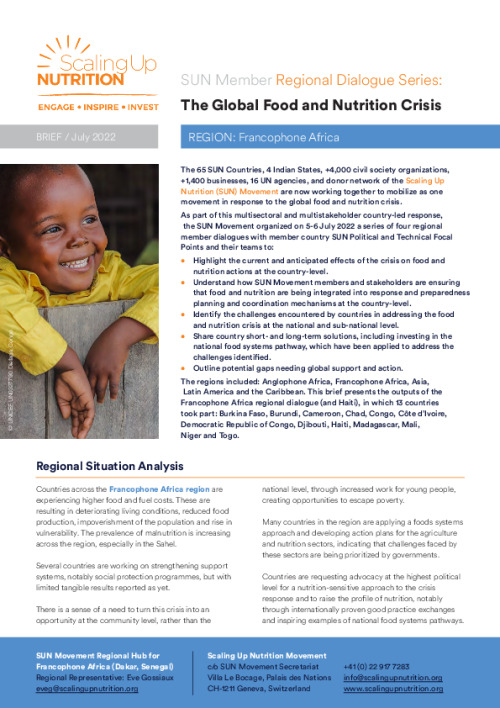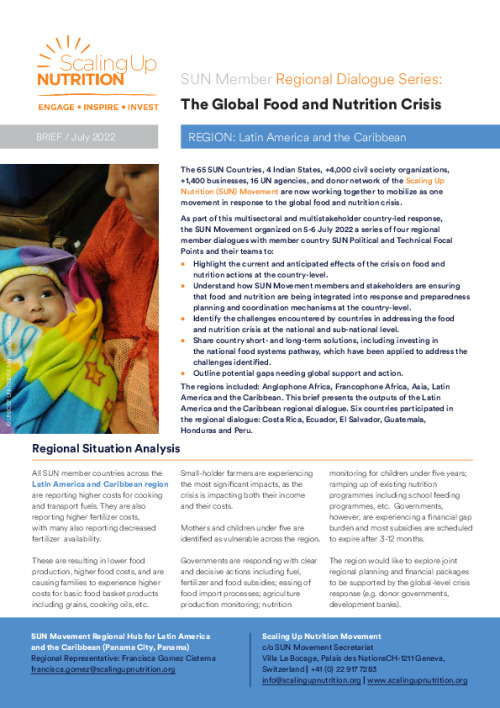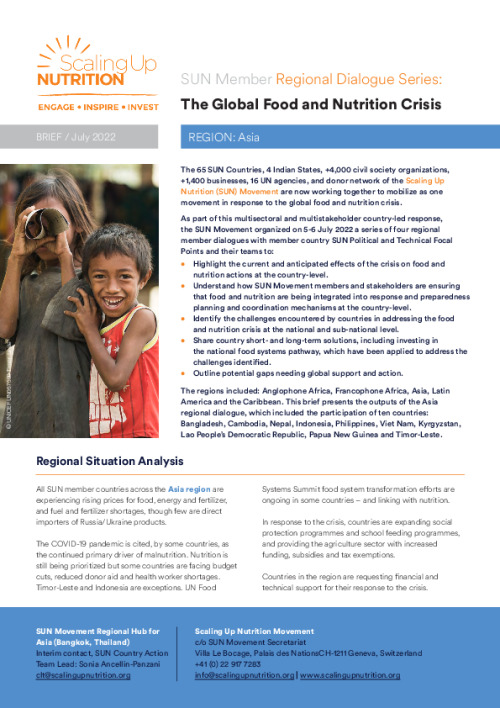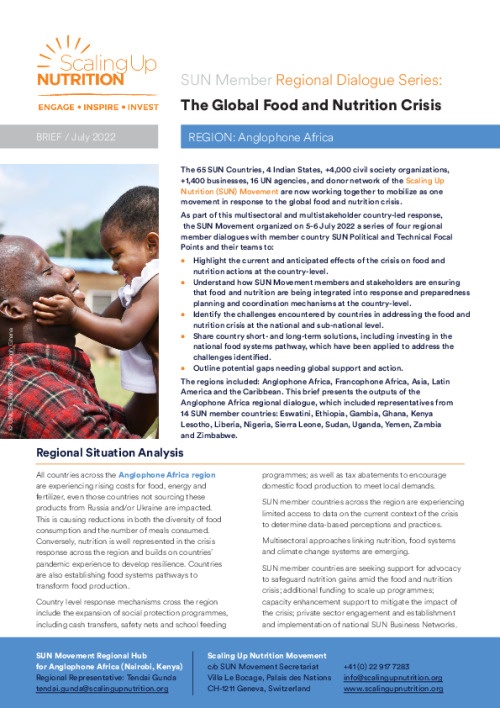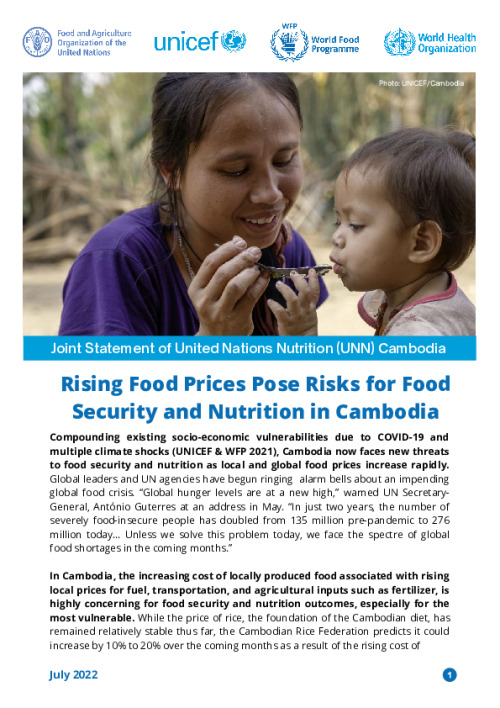SPECIAL FOCUS: Global Food and Nutrition Crisis
The SUN Movement is mobilizing in response to the global food and nutrition crisis
Priorities
Global food and nutrition crisis
Around the world, a global food and nutrition crisis has emerged impacting families, communities and countries. It has been driven by increased costs and decreased availability of key basic food commodities, particularly wheat and cooking oil. This crisis comes on the heels of the health and economic impacts of the global COVID-19 pandemic, as well as the impacts of climate change and other conflicts. It has also been worsened by growing concern about the availability and affordability of fertilizer products, which threatens future agricultural harvests.
The result has caused a significantly worrying situation in many countries – especially those that are heavily dependent on imports for grain, cooking oil and fertilizer; those that were already facing high rates of malnutrition; and those that are facing the double burden of other crises including civil unrest and drought.
As many as 828 million people were affected by hunger and about 2.3 billion people in the world (29%) were moderately or severely food insecure in 2021. Almost 3.1 billion people could not afford a healthy diet in 2020 (SOFI, 2022). An estimated 45 million children under the age of five were suffering from wasting, 149 million had stunted growth, and 39 million were overweight in 2021 (JME, 2021). These figures will continue to rise unless systemic changes are made, and nutrition is included in national and global crisis response plans.
For the SUN Movement, this represents a critical moment – both to support countries to ensure that nutritious foods remain available to everyone and to ensure that the global response to the current crisis is country-led, country-driven. In this regard, the global response needs to take into account the impacts and the challenges identified by countries, but also importantly, country-identified solutions.
More information
- Read more about this perspective in an analysis authored by SUN Coordinator, Gerda Verburg and partners published in the journal Nature.
- Hear SUN Coordinator, Gerda Verburg share how the SUN Movement tackles malnutrition through collaboration, and the importance of "nutrition" featuring in the global response to the food and nutrition crisis.
SUN Member Dialogues
To support countries, the SUN Movement has mobilized to identify, capture and share information, knowledge, experiences and more, which can be used to:
- Inform strategic decision-making
- Advocate for a country-driven response approach
- Support country-identified solutions
The SUN Movement is supporting countries to share both the challenges they are facing due to the global food and nutrition crisis, but also to share the innovative solutions they are putting into action.
By bringing SUN Members together to exchange information, experiences and ideas, we are mobilizing the Movement to respond with impact to the crisis.
Access recordings of these SUN Member Dialogues below, and download our Brief: Global Food and Nutrition Crisis for more information.
Key challenges shared by SUN Members:
- Increased costs of food, fertilizer, and fuel are affecting all countries.
- Even countries that are not directly dependent on Russia and Ukraine for food, fertilizer, and fuel are experiencing inflation and rising prices exacerbating the impacts of the COVID-19 pandemic, climate change.
- Countries with food stocks are deploying these to meet demands but most are entering the lean season and are facing significantly reduced production in the next harvest due to steep rise in fertilizer, fuel, and transportations costs.
- This is causing households to eat less, skip meals, reduce food diversity, and increasingly turn to unhealthy diets.
- Nutrition is well represented in the crisis response in some countries, building on pandemic experience to build resilience and linking with UN Food Systems Summit pathways to transform food production, but in many, nutrition gains are being lost due to rising costs, reduced budgets, rise in vulnerability to and prevalence of malnutrition .
What SUN Countries are doing in response -- "local solutions to local problems”
- Nutrition surveillance is being used to identify and map the worst affected areas and to target food and nutrition actions.
- Budget allocations are being safeguarded or increased for nutrition.
- Multisector coordination and linkages with the UN Food Systems Summits process is being made.
- Subsidies for agriculture, food, fuel, and fertilizer as well as tax exemptions are being implemented.
- Market food prices and availability are being monitored.
- Diversification of food products and increased awareness, production and consumption of local foods is being promoted.
- Climate-smart agriculture is being scaled up.
- The reduction of food loss and waste is being promoted through consumer awareness-raising initiatives.
- Agricultural producers are being trained in production of a wider range of crops and use of alternative agricultural inputs.
- School feeding programmes and other social protection mechanisms are being strengthened and/or expanded in many countries.
- Private sector engagement is being done to include the sector in response actions.
Global Crisis Response Group
United Nations Secretary-General António Guterres has convened the Global Crisis Response Group (GCRG) to advance a response on food, fuel and finance issues. The SUN Coordinator is a member of the GCRG Networking Group on Food, ensuring that the voices of SUN Countries are included in global response considerations. On the topic of nutrition, the GCRG 2nd Brief (June 2022), identified that:
- People are coping with the crisis on a day-to-day basis through actions with worrying long-term consequences for nutrition and early childhood development therefore converting what can be a short-term crisis into a long-term protracted crisis with severe consequences on long term poverty, income distribution and development outcomes for decades to come if immediate actions are not taken.
- People are already reducing food purchases, and may be reducing the number of nutritious items, skipping meals or eating smaller portions. Women and girls who often eat less and eat last are particularly affected.
- Because of the shock of the war, among other factors, the number of chronically undernourished people are expected to increase in 2022, according to FAO. Under a moderate shock scenario, the global number of undernourished people in 2022 would increase by 7.6 million. Under a severe shock scenario, the number of undernourished people will increase by 13.1 million.
- Simulating the export shortfall expected from Ukraine and the Russian Federation during 2022 and 2023, and assuming no increase in the global availability of food as a result of increased food production elsewhere, FAO expects the number of undernourished people will increase by close to 19 million in 2023.
- Special attention must be given to the nutritional needs of the vulnerable, as well as women and children.


